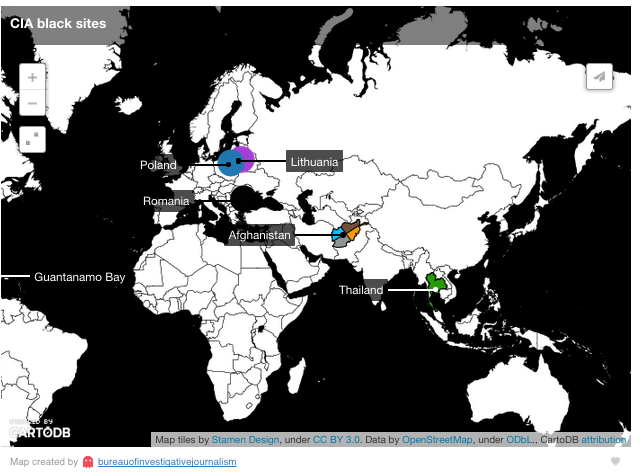Report reveals censored passages about CIA’s secret torture sites

The Senate Intelligence Committee report’s used color-based code names to conceal the CIA’s prison sites. It took researchers at the UK-based Bureau of Investigative Journalism and The Rendition Project nine months to match the code names with public source data in order to point to the specific countries where prisoners were taken to black sites. They also discovered how long prisoners were detained, and what happened afterwards.
Through the work, researchers were able document the movements of 119 prisoners over a three-year period from 2002 to 2005.
The report’s authors said that under the CIA’s rendition, detention and interrogation program, more than 130 people are known to have been tortured in the agency’s own secret prisons, which operated across the world between 2001-2009.
The boom and bust of the black site network - new piece and heaps of data from me and @sam_raph https://www.thebureauinvestigates.com/2015/10/14/revealed-...
One such account involves the CIA capture of a Palestinian man in Pakistan named Abu Zubaydah, in late March 2002, who they wrongly thought was the “number three in Al-Qaeda.” Since the program was in the beginning stages, the CIA did not know where to hold him, and this resulted in a succession plans meant to keep the program secret and avoid detection by a watchdog agency like the International Committee of the Red Cross or even the US’ own military.
The CIA began its rendition and torture program by using the black site nicknamed “Green” in Thailand where officials agreed to host the site and provide security for it, but then “problems with the hosts soon emerged.”
“Reshuffles of Thai government personnel meant that the CIA Station Chief had to engage in ‘continued lobbying’ to keep the prison open. Less than a month after the site was set up, the agency estimated that the numbers of Thai officials who knew about it was already in double figures. It did not take long for media organizations to pick up on the fact that the CIA’s most important catch was being held in Thailand,” according to the report.

The Thailand site was where the CIA interrogators pioneered their torture techniques by repeatedly waterboarding Abu Zubaydah, depriving him of sleep, forcing him into stress positions and holding him in boxes. He once spent 11 days in a coffin-shaped box, and another box was less than three square feet, in which he spent 29 hours.
"I was told during this period that I was one of the first to receive these interrogation techniques, so no rules applied. It felt like they were experimenting and trying out techniques to be used later on other people," said Zubaydah, according to the International Committee of the Red Cross.
Researchers were able highlight a medical officer who observed one of Zubaydah’s interrogations in August 2002, when he wrote the following:
“The sessions accelerated rapidly progressing quickly to the water board after large box, walling, and small box periods. [Abu Zubaydah] seems very resistant to the water board. Longest time with the cloth over his face so far has been 17 seconds. This is sure to increase shortly. NO useful information so far … He did vomit a couple of times during the water board with some beans and rice. It’s been 10 hours since he ate so this is surprising and disturbing. We plan to feed Ensure for a while now. I’m head[ing] back for another water board session.”
The report found that six months later, the Thailand prison was judged to be too risky and the site was closed down on December 4, 2002. The two prisoners held there were Zubaydah and the suspected organizer of the 2000 bombing of the USS Cole in Aden, Yemen: Abd Al-Rahim al-Nashiri.

CIA torture survivors sue psychologists who designed infamous program
It was the International Committee of the Red Cross that wrote a December 2003 letter to US authorities containing a “fairly complete list of CIA prisoners,” informing them of their discovery that CIA prisoners in Afghanistan were held “incommunicado for extensive periods of time, subjected to unacceptable conditions of internment, to ill treatment and torture, while deprived of any possible recourse.”
The Senate report authors said “the host country (Afghanistan) had no independent reason to detain these individuals and held them solely at the behest of the CIA.”
Additionally, the report found that the CIA‘s authority to operate prisons began with a document called a “covert action memorandum of notification,” (MON) – a secret order signed by President George W. Bush the week after the 9/11 attacks. The MON gave the agency permission not only to take prisoners but also to decide whom to detain, why and for how long.
Even with the MON approved, the report unearthed discussions lasting several weeks that raised concerns about whether the risks were too great, the threats of possible media exposure, diplomatic problems with countries hosting prisons, complications over site maintenance, and doubts about whether military custody was the best long-term solution.
The report’s findings are being released as three men who went through “enhanced interrogation” techniques while being detained at Guantanamo Bay are suing the psychologists who developed the torture techniques used by the CIA.
Of the CIA’s 119 prisoners, the report said 42 were now known to have been released, 30 are still in custody, and seven have died. Of the rest, “some are still in custody abroad, while others remain untraced.”














Add new comment